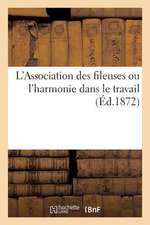Apollo's Angels
Autor Jennifer Homansen Limba Engleză Paperback – sep 2011
| Toate formatele și edițiile | Preț | Express |
|---|---|---|
| Paperback (2) | 145.45 lei 3-5 săpt. | +29.28 lei 4-10 zile |
| GRANTA BOOKS – sep 2011 | 145.45 lei 3-5 săpt. | +29.28 lei 4-10 zile |
| Random House Trade – 31 oct 2011 | 146.19 lei 3-5 săpt. |
Preț: 145.45 lei
Nou
Puncte Express: 218
Preț estimativ în valută:
27.84€ • 28.95$ • 22.98£
27.84€ • 28.95$ • 22.98£
Carte disponibilă
Livrare economică 25 martie-08 aprilie
Livrare express 08-14 martie pentru 39.27 lei
Preluare comenzi: 021 569.72.76
Specificații
ISBN-13: 9781847082565
ISBN-10: 1847082564
Pagini: 672
Ilustrații: Illustrations
Dimensiuni: 144 x 226 x 48 mm
Greutate: 0.71 kg
Editura: GRANTA BOOKS
ISBN-10: 1847082564
Pagini: 672
Ilustrații: Illustrations
Dimensiuni: 144 x 226 x 48 mm
Greutate: 0.71 kg
Editura: GRANTA BOOKS
Extras
Chapter 1
Kings of Dance
Music and Dancing, not only give great pleasure but have the honour of depending on Mathematics, for they consist in number and in measure. And to this must be added Painting and Perspective and the use of very elaborate Machines, all of which are necessary for the ornament of Theatres at Ballets and at Comedies. Therefore, whatever the old doctors may say, to employ oneself at all this is to be a Philosopher and a Mathematician.
-Charles Sorel
According to Aristotle, ballet expresses the actions of men, their customs and their passions. -Claude-François Ménestrier
The king's grandeur and majesty derive from the fact that in his presence his subjects are unequal. . . . Without gradation, inequality, and difference, order is impossible. -Le Duc de Saint- Simon
It is to this noble subordination that we owe the art of seemliness, the elegance of custom, the exquisite good manners with which this magnificent age [of Louis XIV] is imprinted. -Charles-Maurice de Talleyrand
WHEN THE FRENCH king Henri II wedded the Florentine Catherine de Medici in 1533, French and Italian culture came into close and formal alliance, and it is here that the history of ballet begins. The French court had long reveled in tournaments, jousting, and masquerades, but even these impressive and lavish entertainments fell short of those traditionally mounted by the princes and nobility of Milan, Venice, and Florence: flaming torch dances, elaborate horse ballets with hundreds of mounted cavaliers arranged in symbolic formations, and masked interludes with heroic, allegorical, and exotic themes.
The ballet master Guglielmo Ebreo, writing in Milan in 1463, for example, described festivities that included fireworks, tightrope walkers, conjurers, and banquets with up to twenty courses served on solid gold platters with peacocks wandering on the tables. On another occasion, in 1490, Leonardo da Vinci helped to stage Festa de paradiso in Milan, featuring the Seven Planets along with Mercury, the three Graces, the seven Virtues, nymphs, and the god Apollo. The Italians also performed simple but elegant social dances known as balli and balletti, which consisted of graceful, rhythmic walking steps danced at formal balls and ceremonies, or on occasion stylized pantomime performances: the French called them ballets.1
Catherine (who was only fourteen when she married) dominated the French court for many years after Henri's death in 1559, bringing her Italianate taste to bear on French courtiers-and kings. Her sons, the French kings Charles IX and Henri III, carried the tradition forward: they admired the floats, chariots, and parades of allegorical performances they saw in Milan and Naples, and shared their mother's keen interest in ceremonial and theatrical events. In their hands, even strictly Catholic processionals could morph into colorful masquerades, and both monarchs were known to promenade through the streets at night dressed en travesti, adorned with gold and silver veils and Venetian masks, accompanied by courtiers in similar attire. Chivalric themes enacted with dancing, singing, and demonstrations of equestrian skill made for impressive theatrical collages, such as the joust held at Fontainebleau in 1564, which included a full-scale reenactment of a castle siege and battles between demons, giants, and dwarfs on behalf of six beautiful nymphs in captivity.
These festivities, so seemingly gay in their extravagances, were not mere frivolous diversions. Sixteenth-century France was beset with intractable and savage civil and religious conflicts: the French kings, drawing on a deep tradition of Italian Renaissance thought and princely patronage of the arts, thought of spectacle as a way to soothe passions and calm sectarian violence. Catherine herself was no saint of tolerance, as her role in the murder of Huguenots in Paris during the St. Bartholomew's Day massacre in 1572 proved. But the brutality of this event should not blind us to the fact that she, her sons, and many others also genuinely hoped that theatrical events might be an important political tool, assuaging tensions and pacifying warring parties.
It was in this spirit that Charles IX established in 1570 the Académie de Poésie et de Musique, modeled after the famous Renaissance Florentine Platonic Academy and drawing its members from a circle of distinguished French poets, including Jean-Antoine de Baïf, Jean Dorat, and Pierre de Ronsard.* Profoundly influenced by Neoplatonism, these poets believed that hidden beneath the shattered and chaotic surface of political life lay a divine harmony and order- a web of rational and mathematical relations that demonstrated the natural laws of the universe and the mystical power of God. Melding their own deeply religious beliefs with the Platonic notion of a secret and ideal realm more real than their own perceived world, they sought to remake the Christian church-not through the old practices of Catholic liturgy but through theater and art, and above all through the classical forms of pagan antiquity. Working with players, poets, and musicians, these men hoped to create a new kind of spectacle in which the rigorous rhythms of classical Greek verse would harmonize dance, music, and language into a measured whole. Number, proportion, and design, they felt, could elucidate the occult order of the universe, thus revealing God.
A powerful alloy of mystical theology, recondite magic, and classical rigor, the new Academy represented a distinct form of idealism: music and art could summon men to their highest capacities and goals. The key lay in turning spirituality and learning to concrete theatrical effect. And so the Academy proposed an encyclopedic course of inquiry, including natural philosophy, languages, mathematics, music, painting, and the military arts. The focus, as one adherent later explained, was to perfect man "both in mind and body." Music-"the beautiful part of mathematics"-held a special place, with its celestial harmonies, Pythagorean logic, and penetrating emotional intensity seen as an unmatched suasion. "Songs," it was said (following Plato), "are the spells for souls." Or, as the statutes of the Academy put it, a
bit more dryly, "where music is disordered, there morals are also depraved, and where it is well ordered, there men are well disciplined morally."2
So it was with dance. Indeed, the Academicians saw in ballet a chance to take man's troublesome passions and physical desires and redirect them toward a transcendent love of God. The body had long been seen as pulling man down, sacrificing his higher spiritual powers to material needs. On the Great Chain of Being, ranking all living things from the lowliest vegetative and material creatures up to the angels who occupied the highest rungs near God, man was consigned to the middle rungs: suspended perilously between beasts and angels, his highest spiritual aspirations were forever constrained by his earthly ties and gross bodily functions.
But if he danced, so the men of the Academy believed, man might break some of these earthly ties and raise himself up, closer to the angels. The movements of the body, disciplined with poetic rhythm and meter and brought into accord with musical and mathematical principles, could tune him to celestial harmonies. Pontus de Tyard, a poet involved with the Academy, wrote of the logic justifying such claims in characteristically humanist terms: "The spread of the two arms and the extreme opening of the legs correspond to the height of the man: as does the length of the head multiplied eight or nine or ten times, according to different statues." It was this sense of perfect mathematical proportion that led the Abbé Mersenne, in a moment of high inspiration in 1636, to refer to "the author of the Universe" as "the great Ballet-master."3
To bring these lofty ideals to theatrical life the artists of the Academy labored to fit poetry and music to the meter of Greek verse. They scanned dance steps following a pattern of long and short syllables and notes, thus training gestures, walking, and skipping motions to the rhythms of music and poetry. Every Sunday the players performed for the king and other patrons. In sharp contrast to the lively social occasions of court performances, in which eating, drinking, and conversation were commonplace, the concerts at the Academy were given in absolute silence, and no one would be seated after the music and dances began. It was this devotional character that made subsequent generations of Catholic thinkers admire the Academicians as "Christian Orpheuses" who proved that with musical discipline "the whole of Gaul, in fact the whole world should ring to the greater glory of God and the hearts of all be inflamed with divine love."4
In 1581 the researches of the Academy came to fruition in the Ballet comique de la Reine. This ballet was given in celebration of the marriage of the queen's sister, Marguerite de Vaudémont, to the Duc de Joyeuse, himself an ardent supporter of the Academy. The Ballet comique was one of seventeen entertainments, including tournaments, a horse ballet, and fireworks, and the poets of the Academy prepared the celebrations in the ancient style, mixing sung verse, music, and dance. Performed in Paris in a large salle at the Petit-Bourbon to an audience of "persons of mark," the spectacle nonetheless attracted crowds numbering in the thousands who pressed their way to the palace, eager to witness the event. As was not uncommon, the performance began at 10:00 p.m. and lasted nearly six hours, finishing deep in the night.5
It was a spectacular but intimate affair. Elevated platform stages did not yet exist, and the actors of the Ballet comique performed up close in the audience's midst. The story they told was an allegorical tale of the enchantress Circe vanquished by the powerful gods Minerva and Jupiter. Like painters, ballet masters commonly worked with mythological manuals, thick reference books that detailed the allegorical and symbolic character of gods and goddesses. The story thus worked on many levels, which spectators at the time would have grasped: it was a tale of passions subjugated to reason and faith (a blunt reference to religious fanaticism), of the king and queen subduing their enemies, of discord resolved and the triumph of reconciliation and peace (the ballet was staged just nine years after the St. Bartholomew's Day massacre). As the dancing master Balthasar de Beaujoyeulx himself wrote in the preface to the ballet, "And now, after so many unsettling events . . . the ballet will stand as a mark of the strength and solidity of your Kingdom. . . . The blush of color has returned to your France."6
The dances were designed to prove the point. Created by Beaujoyeulx (celebrated by one contemporary as "a uniquely creative geometer"), they traced perfectly formed figures across the floor in tightly measured steps: circles, squares, and triangles, each demonstrating the ways that number, geometry, and reason ordered the universe and men's souls. At the end of the performance Circe bowed down and presented her magic wand to the king, and a grand ballet unfolded with twelve naiads in white, four dryads in green, and the queen and princesses forming and re-forming chains and shapes. "So dexterously did each dancer keep her place and mark the cadence," wrote Beaujoyeulx, "that the beholders thought that Archimedes himself had not a better understanding of geometrical proportions." Those watching, he hoped, would be "filled with awe."7
Many were. The Ballet comique de la Reine was lauded at the time and later engraved in French memory as the first of a new genre, the ballet de cour, which imposed what one scholar has called an "intense and exact classicism" on the heretofore freewheeling practices of medieval spectacle. Before the Ballet comique de la Reine, the dances in court performances were more like stylish walking than ballet. In the Ballet comique de la Reine, by contrast, there was a formal discipline and design, derived from the desire to make dance and music a measure of the order of the universe. It was the authors' concrete precision-their preoccupation with mapping the length, duration, measure, and geometry of a step-combined with their expansive spiritual aspirations that laid the groundwork for classical dance technique as we now know it. This was the base upon which ballet masters nearly a century later would build when, under the reign of the French king Louis XIV, they would systematize and codify ballet's steps according to a set of strict geometric principles.8
The Ballet comique de la Reine and the emergence of the ballet de cour thus marked an important departure from earlier practices: they invested dance with a serious, even religious purpose and joined it to French intellectual and political life. A strong idealistic strain derived from Renaissance humanism and amplified by the Catholic Counter-Reformation made cultivated men like those at the Academy believe that by welding dance, music, and poetry into a coherent spectacle they might actually begin to bridge the yawning gap between earthly passions and spiritual transcendence. It was a breathtaking ambition, and one that never really died in ballet, even if in more skeptical times it was sometimes forgotten or derided. The artists who created the Ballet comique de la Reine genuinely hoped to elevate man, to raise him up a rung on the Great Chain of Being and bring him closer to the angels and God.
Not everyone at the time, however, appreciated the significance of the Ballet comique de la Reine. If some spectators found themselves awed, others were angered: how could the king waste such vast resources on a lavish entertainment in a time of civil war and strife? Henri III had long been criticized for his obsession with the Academy. One critic nailed a notice to the chamber where its poets met with the king, charging, "While France, crushed everywhere by civil war, is falling into ruin, our King practices grammatical exercises." He had a point, and indeed the high-minded enthusiasms of the men of the Academy were soon swept away in the violence that marked and finally ended Henri's ill-fated reign. Forced to flee Paris by the reactionary pro-Spanish Catholic League, which had designs on the throne, Henri had its leaders murdered only to be slain himself at the hand of a monk in 1589.9
The ideas first crystallized in the Ballet comique de la Reine, however, cast a long shadow. Well into the seventeenth century, distinguished scientists, poets, and writers looked back with admiration to the Academy's experiments, especially as Europe faced the renewed violence of the Thirty Years, War (1618-48). The Abbé Mersenne, whose home in the convent of Minimes at the Place Royal in Paris became a "post office" for the life of the mind in Europe in the first half of the century, wrote about the ballet de cour, and many of his friends and colleagues, including René Descartes, also discussed the art and in some cases even tried their hand at writing ballets. (Descartes offered the Ballet de la Naissance de la Paix to the queen of Sweden in 1649, just before his death.) At court, ballet remained central: the French queen Marie de Medici (Florentine by birth) held ballets in her apartments every Sunday and increased the number of performances at court. And her son King Louis XIII (1601-1643) became a fine dancer and avid performer.10
But it was not really the same. Under Louis XIII the lingering Neoplatonic ideals of the Academy faded in favor of a more instrumental raison d'état. As Louis and his formidable first minister, Cardinal de Richelieu, set about pulling the disparate and warring forces of France under the strengthening arm of the French state and making the king's power over his realm absolute, the meaning and character of ballet changed-it had to. Louis and Richelieu were more concerned with power than God, and rather than revealing the order of the universe, the ballet de cour now magnified the grandeur of the king. Thus the intellectual seriousness of the Ballet comique de la Reine gave way to a more bombastic and flattering style. This too would be an enduring aspect of ballet.
From the Hardcover edition.
Kings of Dance
Music and Dancing, not only give great pleasure but have the honour of depending on Mathematics, for they consist in number and in measure. And to this must be added Painting and Perspective and the use of very elaborate Machines, all of which are necessary for the ornament of Theatres at Ballets and at Comedies. Therefore, whatever the old doctors may say, to employ oneself at all this is to be a Philosopher and a Mathematician.
-Charles Sorel
According to Aristotle, ballet expresses the actions of men, their customs and their passions. -Claude-François Ménestrier
The king's grandeur and majesty derive from the fact that in his presence his subjects are unequal. . . . Without gradation, inequality, and difference, order is impossible. -Le Duc de Saint- Simon
It is to this noble subordination that we owe the art of seemliness, the elegance of custom, the exquisite good manners with which this magnificent age [of Louis XIV] is imprinted. -Charles-Maurice de Talleyrand
WHEN THE FRENCH king Henri II wedded the Florentine Catherine de Medici in 1533, French and Italian culture came into close and formal alliance, and it is here that the history of ballet begins. The French court had long reveled in tournaments, jousting, and masquerades, but even these impressive and lavish entertainments fell short of those traditionally mounted by the princes and nobility of Milan, Venice, and Florence: flaming torch dances, elaborate horse ballets with hundreds of mounted cavaliers arranged in symbolic formations, and masked interludes with heroic, allegorical, and exotic themes.
The ballet master Guglielmo Ebreo, writing in Milan in 1463, for example, described festivities that included fireworks, tightrope walkers, conjurers, and banquets with up to twenty courses served on solid gold platters with peacocks wandering on the tables. On another occasion, in 1490, Leonardo da Vinci helped to stage Festa de paradiso in Milan, featuring the Seven Planets along with Mercury, the three Graces, the seven Virtues, nymphs, and the god Apollo. The Italians also performed simple but elegant social dances known as balli and balletti, which consisted of graceful, rhythmic walking steps danced at formal balls and ceremonies, or on occasion stylized pantomime performances: the French called them ballets.1
Catherine (who was only fourteen when she married) dominated the French court for many years after Henri's death in 1559, bringing her Italianate taste to bear on French courtiers-and kings. Her sons, the French kings Charles IX and Henri III, carried the tradition forward: they admired the floats, chariots, and parades of allegorical performances they saw in Milan and Naples, and shared their mother's keen interest in ceremonial and theatrical events. In their hands, even strictly Catholic processionals could morph into colorful masquerades, and both monarchs were known to promenade through the streets at night dressed en travesti, adorned with gold and silver veils and Venetian masks, accompanied by courtiers in similar attire. Chivalric themes enacted with dancing, singing, and demonstrations of equestrian skill made for impressive theatrical collages, such as the joust held at Fontainebleau in 1564, which included a full-scale reenactment of a castle siege and battles between demons, giants, and dwarfs on behalf of six beautiful nymphs in captivity.
These festivities, so seemingly gay in their extravagances, were not mere frivolous diversions. Sixteenth-century France was beset with intractable and savage civil and religious conflicts: the French kings, drawing on a deep tradition of Italian Renaissance thought and princely patronage of the arts, thought of spectacle as a way to soothe passions and calm sectarian violence. Catherine herself was no saint of tolerance, as her role in the murder of Huguenots in Paris during the St. Bartholomew's Day massacre in 1572 proved. But the brutality of this event should not blind us to the fact that she, her sons, and many others also genuinely hoped that theatrical events might be an important political tool, assuaging tensions and pacifying warring parties.
It was in this spirit that Charles IX established in 1570 the Académie de Poésie et de Musique, modeled after the famous Renaissance Florentine Platonic Academy and drawing its members from a circle of distinguished French poets, including Jean-Antoine de Baïf, Jean Dorat, and Pierre de Ronsard.* Profoundly influenced by Neoplatonism, these poets believed that hidden beneath the shattered and chaotic surface of political life lay a divine harmony and order- a web of rational and mathematical relations that demonstrated the natural laws of the universe and the mystical power of God. Melding their own deeply religious beliefs with the Platonic notion of a secret and ideal realm more real than their own perceived world, they sought to remake the Christian church-not through the old practices of Catholic liturgy but through theater and art, and above all through the classical forms of pagan antiquity. Working with players, poets, and musicians, these men hoped to create a new kind of spectacle in which the rigorous rhythms of classical Greek verse would harmonize dance, music, and language into a measured whole. Number, proportion, and design, they felt, could elucidate the occult order of the universe, thus revealing God.
A powerful alloy of mystical theology, recondite magic, and classical rigor, the new Academy represented a distinct form of idealism: music and art could summon men to their highest capacities and goals. The key lay in turning spirituality and learning to concrete theatrical effect. And so the Academy proposed an encyclopedic course of inquiry, including natural philosophy, languages, mathematics, music, painting, and the military arts. The focus, as one adherent later explained, was to perfect man "both in mind and body." Music-"the beautiful part of mathematics"-held a special place, with its celestial harmonies, Pythagorean logic, and penetrating emotional intensity seen as an unmatched suasion. "Songs," it was said (following Plato), "are the spells for souls." Or, as the statutes of the Academy put it, a
bit more dryly, "where music is disordered, there morals are also depraved, and where it is well ordered, there men are well disciplined morally."2
So it was with dance. Indeed, the Academicians saw in ballet a chance to take man's troublesome passions and physical desires and redirect them toward a transcendent love of God. The body had long been seen as pulling man down, sacrificing his higher spiritual powers to material needs. On the Great Chain of Being, ranking all living things from the lowliest vegetative and material creatures up to the angels who occupied the highest rungs near God, man was consigned to the middle rungs: suspended perilously between beasts and angels, his highest spiritual aspirations were forever constrained by his earthly ties and gross bodily functions.
But if he danced, so the men of the Academy believed, man might break some of these earthly ties and raise himself up, closer to the angels. The movements of the body, disciplined with poetic rhythm and meter and brought into accord with musical and mathematical principles, could tune him to celestial harmonies. Pontus de Tyard, a poet involved with the Academy, wrote of the logic justifying such claims in characteristically humanist terms: "The spread of the two arms and the extreme opening of the legs correspond to the height of the man: as does the length of the head multiplied eight or nine or ten times, according to different statues." It was this sense of perfect mathematical proportion that led the Abbé Mersenne, in a moment of high inspiration in 1636, to refer to "the author of the Universe" as "the great Ballet-master."3
To bring these lofty ideals to theatrical life the artists of the Academy labored to fit poetry and music to the meter of Greek verse. They scanned dance steps following a pattern of long and short syllables and notes, thus training gestures, walking, and skipping motions to the rhythms of music and poetry. Every Sunday the players performed for the king and other patrons. In sharp contrast to the lively social occasions of court performances, in which eating, drinking, and conversation were commonplace, the concerts at the Academy were given in absolute silence, and no one would be seated after the music and dances began. It was this devotional character that made subsequent generations of Catholic thinkers admire the Academicians as "Christian Orpheuses" who proved that with musical discipline "the whole of Gaul, in fact the whole world should ring to the greater glory of God and the hearts of all be inflamed with divine love."4
In 1581 the researches of the Academy came to fruition in the Ballet comique de la Reine. This ballet was given in celebration of the marriage of the queen's sister, Marguerite de Vaudémont, to the Duc de Joyeuse, himself an ardent supporter of the Academy. The Ballet comique was one of seventeen entertainments, including tournaments, a horse ballet, and fireworks, and the poets of the Academy prepared the celebrations in the ancient style, mixing sung verse, music, and dance. Performed in Paris in a large salle at the Petit-Bourbon to an audience of "persons of mark," the spectacle nonetheless attracted crowds numbering in the thousands who pressed their way to the palace, eager to witness the event. As was not uncommon, the performance began at 10:00 p.m. and lasted nearly six hours, finishing deep in the night.5
It was a spectacular but intimate affair. Elevated platform stages did not yet exist, and the actors of the Ballet comique performed up close in the audience's midst. The story they told was an allegorical tale of the enchantress Circe vanquished by the powerful gods Minerva and Jupiter. Like painters, ballet masters commonly worked with mythological manuals, thick reference books that detailed the allegorical and symbolic character of gods and goddesses. The story thus worked on many levels, which spectators at the time would have grasped: it was a tale of passions subjugated to reason and faith (a blunt reference to religious fanaticism), of the king and queen subduing their enemies, of discord resolved and the triumph of reconciliation and peace (the ballet was staged just nine years after the St. Bartholomew's Day massacre). As the dancing master Balthasar de Beaujoyeulx himself wrote in the preface to the ballet, "And now, after so many unsettling events . . . the ballet will stand as a mark of the strength and solidity of your Kingdom. . . . The blush of color has returned to your France."6
The dances were designed to prove the point. Created by Beaujoyeulx (celebrated by one contemporary as "a uniquely creative geometer"), they traced perfectly formed figures across the floor in tightly measured steps: circles, squares, and triangles, each demonstrating the ways that number, geometry, and reason ordered the universe and men's souls. At the end of the performance Circe bowed down and presented her magic wand to the king, and a grand ballet unfolded with twelve naiads in white, four dryads in green, and the queen and princesses forming and re-forming chains and shapes. "So dexterously did each dancer keep her place and mark the cadence," wrote Beaujoyeulx, "that the beholders thought that Archimedes himself had not a better understanding of geometrical proportions." Those watching, he hoped, would be "filled with awe."7
Many were. The Ballet comique de la Reine was lauded at the time and later engraved in French memory as the first of a new genre, the ballet de cour, which imposed what one scholar has called an "intense and exact classicism" on the heretofore freewheeling practices of medieval spectacle. Before the Ballet comique de la Reine, the dances in court performances were more like stylish walking than ballet. In the Ballet comique de la Reine, by contrast, there was a formal discipline and design, derived from the desire to make dance and music a measure of the order of the universe. It was the authors' concrete precision-their preoccupation with mapping the length, duration, measure, and geometry of a step-combined with their expansive spiritual aspirations that laid the groundwork for classical dance technique as we now know it. This was the base upon which ballet masters nearly a century later would build when, under the reign of the French king Louis XIV, they would systematize and codify ballet's steps according to a set of strict geometric principles.8
The Ballet comique de la Reine and the emergence of the ballet de cour thus marked an important departure from earlier practices: they invested dance with a serious, even religious purpose and joined it to French intellectual and political life. A strong idealistic strain derived from Renaissance humanism and amplified by the Catholic Counter-Reformation made cultivated men like those at the Academy believe that by welding dance, music, and poetry into a coherent spectacle they might actually begin to bridge the yawning gap between earthly passions and spiritual transcendence. It was a breathtaking ambition, and one that never really died in ballet, even if in more skeptical times it was sometimes forgotten or derided. The artists who created the Ballet comique de la Reine genuinely hoped to elevate man, to raise him up a rung on the Great Chain of Being and bring him closer to the angels and God.
Not everyone at the time, however, appreciated the significance of the Ballet comique de la Reine. If some spectators found themselves awed, others were angered: how could the king waste such vast resources on a lavish entertainment in a time of civil war and strife? Henri III had long been criticized for his obsession with the Academy. One critic nailed a notice to the chamber where its poets met with the king, charging, "While France, crushed everywhere by civil war, is falling into ruin, our King practices grammatical exercises." He had a point, and indeed the high-minded enthusiasms of the men of the Academy were soon swept away in the violence that marked and finally ended Henri's ill-fated reign. Forced to flee Paris by the reactionary pro-Spanish Catholic League, which had designs on the throne, Henri had its leaders murdered only to be slain himself at the hand of a monk in 1589.9
The ideas first crystallized in the Ballet comique de la Reine, however, cast a long shadow. Well into the seventeenth century, distinguished scientists, poets, and writers looked back with admiration to the Academy's experiments, especially as Europe faced the renewed violence of the Thirty Years, War (1618-48). The Abbé Mersenne, whose home in the convent of Minimes at the Place Royal in Paris became a "post office" for the life of the mind in Europe in the first half of the century, wrote about the ballet de cour, and many of his friends and colleagues, including René Descartes, also discussed the art and in some cases even tried their hand at writing ballets. (Descartes offered the Ballet de la Naissance de la Paix to the queen of Sweden in 1649, just before his death.) At court, ballet remained central: the French queen Marie de Medici (Florentine by birth) held ballets in her apartments every Sunday and increased the number of performances at court. And her son King Louis XIII (1601-1643) became a fine dancer and avid performer.10
But it was not really the same. Under Louis XIII the lingering Neoplatonic ideals of the Academy faded in favor of a more instrumental raison d'état. As Louis and his formidable first minister, Cardinal de Richelieu, set about pulling the disparate and warring forces of France under the strengthening arm of the French state and making the king's power over his realm absolute, the meaning and character of ballet changed-it had to. Louis and Richelieu were more concerned with power than God, and rather than revealing the order of the universe, the ballet de cour now magnified the grandeur of the king. Thus the intellectual seriousness of the Ballet comique de la Reine gave way to a more bombastic and flattering style. This too would be an enduring aspect of ballet.
From the Hardcover edition.
Notă biografică
Jennifer Homans was a professional dancer trained at the North Carolina School of the Arts, American Ballet Theatre, and The School of American Ballet. She performed with the Chicago Lyric Opera Ballet, the San Francisco Ballet, and Pacific Northwest Ballet. Currently the dance critic for The New Republic, she has written for The New York Times, the International Herald Tribune, The New York Review of Books, and The Australian. She earned her B.A. at Columbia University and her Ph.D. in modern European history at New York University, where she is a Distinguished Scholar in Residence.
From the Hardcover edition.
From the Hardcover edition.
Recenzii
“The only truly definitive history of the most impossibly fantastic art form, ballet . . . an eloquent and lasting elegy to an unlasting art.”—The New York Times Book Review
“A delight to read, massively informed yet remarkably agile . . . The story of ballet offers a singular perspective on the evolution of our culture: a fascinating mirror on the arts. Nowhere is this narrative told more amply and compellingly than in Jennifer Homans’s triumphant Apollo’s Angels.”—The Washington Post
“Here is a book of immense ambition—a one-volume history of ballet—and of considerable accomplishment. Jennifer Homans, whom we know primarily as The New Republic’s provocative dance critic, shows herself to be both dogged and graceful as a historian—a rare and welcome combination of qualities.”—The New York Review of Books
“Intellectually rigorous, beautifully written, brilliantly structured.”—San Francisco Chronicle
“Magnificent . . . [a] monumental work.”—The Boston Globe
“Each page of this luminous work delights, enlightens and beckons. Every dancer should live with this book, of course, but every person who loves literature and history, is word-struck and story-addicted, should give themselves a treat with Apollo’s Angels. Treasure this treasure.”—Jacques d’Amboise
“This is a wonderful book about how ballet evolved. Written by a gifted dancer, Apollo’s Angels is dance history seen from the inside. The wonder to me is how much this accessible, beautifully-crafted book reveals about the times and places in which ballets were made; it makes culture come alive.”—Richard Sennett, author of The Craftsman
“A dancer who is also a historian—who ever dreamed of such an improbable creature? But here is Jennifer Homans and her indispensable book. She puts the understanding of ballet on a whole new footing. Finally the delicacies of ballet have been restored to the indelicacies of history, and the art seems even more wondrous for it. Apollo’s Angels is an enlightenment, a remarkable feat of scholarship and sensibility, an affecting mixture of criticism and devotion, an intellectual joy.”—Leon Wieseltier
“A delight to read, massively informed yet remarkably agile . . . The story of ballet offers a singular perspective on the evolution of our culture: a fascinating mirror on the arts. Nowhere is this narrative told more amply and compellingly than in Jennifer Homans’s triumphant Apollo’s Angels.”—The Washington Post
“Here is a book of immense ambition—a one-volume history of ballet—and of considerable accomplishment. Jennifer Homans, whom we know primarily as The New Republic’s provocative dance critic, shows herself to be both dogged and graceful as a historian—a rare and welcome combination of qualities.”—The New York Review of Books
“Intellectually rigorous, beautifully written, brilliantly structured.”—San Francisco Chronicle
“Magnificent . . . [a] monumental work.”—The Boston Globe
“Each page of this luminous work delights, enlightens and beckons. Every dancer should live with this book, of course, but every person who loves literature and history, is word-struck and story-addicted, should give themselves a treat with Apollo’s Angels. Treasure this treasure.”—Jacques d’Amboise
“This is a wonderful book about how ballet evolved. Written by a gifted dancer, Apollo’s Angels is dance history seen from the inside. The wonder to me is how much this accessible, beautifully-crafted book reveals about the times and places in which ballets were made; it makes culture come alive.”—Richard Sennett, author of The Craftsman
“A dancer who is also a historian—who ever dreamed of such an improbable creature? But here is Jennifer Homans and her indispensable book. She puts the understanding of ballet on a whole new footing. Finally the delicacies of ballet have been restored to the indelicacies of history, and the art seems even more wondrous for it. Apollo’s Angels is an enlightenment, a remarkable feat of scholarship and sensibility, an affecting mixture of criticism and devotion, an intellectual joy.”—Leon Wieseltier





























